Recent Comments
Subscribe Via Email
Find us on Facebook
Follow Us on Pinterest
Unable to load Pinterest pins for 'FrancesSuzanne'
Jul
8
We have slowly made the realization that we will not be one of “those bloggers.” You know the ones. They are the ones that you can recognize the maker of a sewn garment without any clues as to whom it might be, all due to styling, fabric coordination, photography, etc. This has taken us a while to accept because let’s face it: we really, really, really wanted to be one of them….
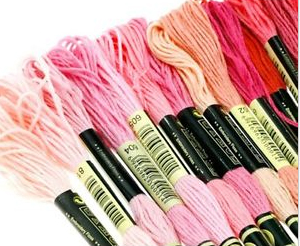
However, what we HAVE come to realize, is that we see an underlying theme emerging through our work. That theme is the incorporation of hand work on many of our creations, whether on knits, cotton, or finer fabric. No, it’s not on everything we make {so much to sew, so little time}, but when it IS incorporated, the sewn garment elevates to one we are a bit more proud of creating…
Through the past three years, many of you have expressed an interest in using handwork in your garments, but just aren’t sure how to begin. And while we tell those of you that ask, “it’s easy…it just takes a little time.” we aren’t sure you really believe us.
Sooooooooo, we thought we might give you a little push to delve into handwork of your own. And while there are a number of different types of handwork, our focus for today is SMOCKING. Think of this post as one that gives a little background information / terminology / where to begin for the beginner smocker. No….it won’t tell you everything about smocking, or probably even scratch the surface, but it is a START toward learning a new skill.
And, *PSST….DISCLAIMER: We don’t know everything there is to know about smocking {by a LONG stretch}, but we know some basics {that’s all you need to get started anyway} as well as some resources we frequent when completing projects.
What is smocking? It is embroidery stitches used to hold a wide piece of gathered cloth in even pleats / folds.
There are two main types of smocking – English and American. Lisa, of Mommy’s Apron Strings, did a great job explaining the difference between the two. We have only done English smocking on our projects, but American smocking would be fun to try out on a pocket, or something small, and the type of smocking you could do without a pleater.
What is a pleater? A pleater is used to pleat the fabric in preparation to smock. Pleaters come in various sizes – generally speaking, the more rows you have on your pleater, the more expensive the cost. They are also available to purchase with whole rows or half rows of pleats.
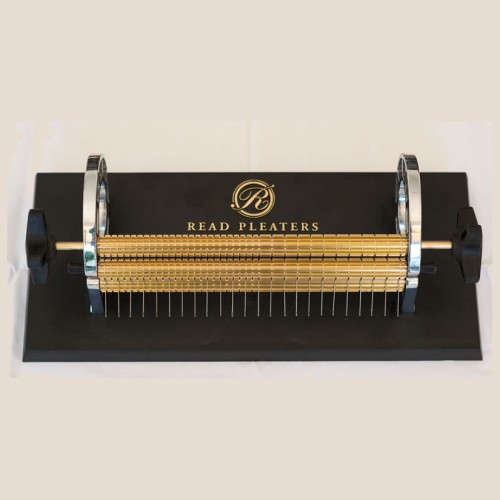
If you don’t want to invest in a pleater, that’s fine {we don’t have one either}! There are ready-to-smock items available for purchase {LOADS are found here}, or if you are like us and want to pick out your fabric, many heirloom shops will pleat the selected fabric for you. In fact, we recently had one pleated here for an upcoming project.
Prior to pleating a garment, you will need to determine what you want to smock. This is called a smocking plate. There are two types of plates: geometric smocking plates and picture smocking plates.
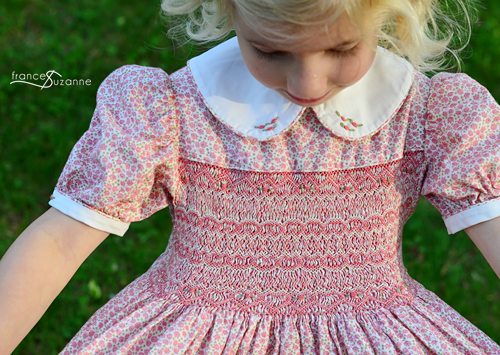
Geometric Smocking {as seen on smocked yoke}
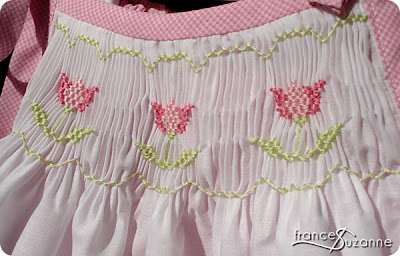
Most people begin with geometric smocking {in order to learn the stitches} before moving into picture smocking. When one sews using picture smocking, this is called stacking {because it is merely stacking cable stitches one on top of another}. We still prefer geometric smocking over picture smocking.
Generally, smocking is found on a yoke, a bishop, or an insert.
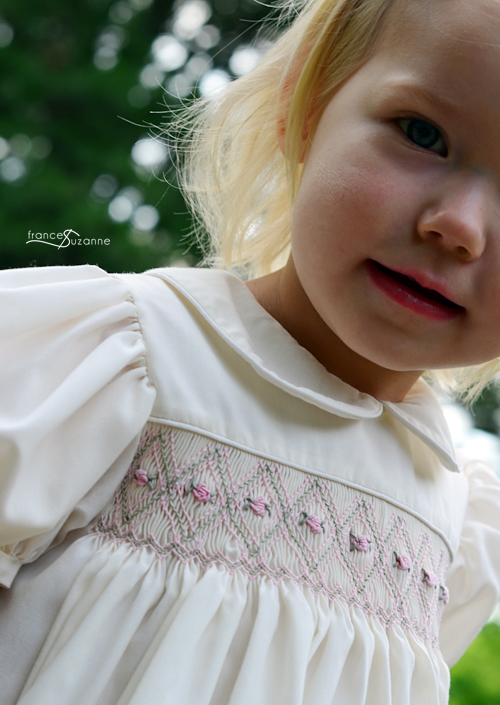

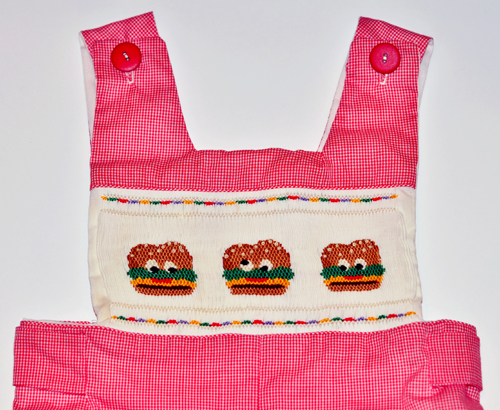
A Smocked Insert {not blogged about, or ironed – straight from “the bin”}
Of course, there are some other beautiful areas to incorporate smocking as well {as seen here and here}. Each of these smocking forms require blocking {a fancy word for “sizing” the pleated area to the correct size}. We use the Heirloom Stitcher’s Shape ‘N Press to size our bishops to the correct size. You block your garment prior to smocking, as well as after completing your smocking {before you sew the garment}. Blocking requires LOTS of pins, and even more starch!!
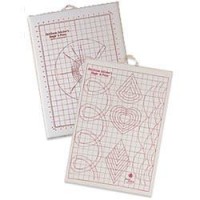
There are a plethora of online resources available for those interested in smocking – from inspirational looks…to books…to beginner kits. You can’t go wrong with Australian Smocking and Embroidery magazines. MULTIPLE PAGES are dedicated to stitches, detailing how to make each one. Ellen McCarn on English Smocking is an excellent book for beginning sewists {geometric plates}. Perfecting Picture Smocking {by Laura Jenkins Thompson} is another terrific book, but obviously for beginning sewists of picture smocking plates!

As for inspiration? Well there are always the blogs of: Kathy’s Sewing Adventures, Martha’s Southern Matriarch, Creations by Michie, and Gail’s Lulu and Annie just to name a few. All of these ladies are PHENOMENAL!! Absolutely stellar…and KNOW. THEIR. STUFF!! Not to mention, so eager to help others when asked…**Yes, that is spoken with experience because they’ve helped us out, time and time again!!
Then, you can always join the SAGA Facebook page. SAGA is the acronym for “Smocking Arts Guild of America” – a deceptive name, because they do other forms of handwork other than smocking. There, you can see handwork inspiration, as well as ask for help when needed. Yes, it is a guild…and one that is open for annual memberships too.
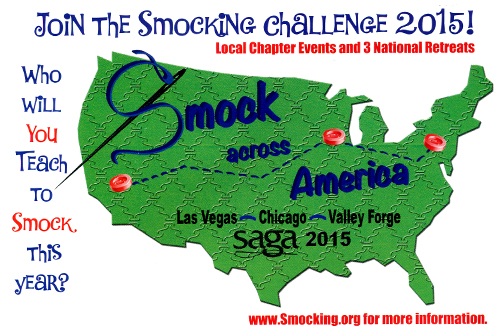
If you are anxious to give smocking a try, you might want to purchase an inexpensive Smock-a-Stitch Starter Kit from The Children’s Corner Store. This kit includes a sample pleated insert, a smocking needle, one skein of DMC embroidery thread, and basic instructions. What better way to practice and refine some basic smocking stitches??
So, there you have a little background information and terminology for smocking! And, you’re right. There’s been no mention of thread …. or needles … or smocking stitches …. YET! Just the background “stuff.” Hope this whets your smocking appetites a bit, and you want to find out more about the process and/or give it a try …
For all you “fellow smockers” out there, feel free to chime in on the comment section with your favorite, go-to resources for smocking! It’s always refreshing to hear from you, and your preferred resources.
And, if you are not currently smocking, but would like to know more about a specific aspect of it, please comment with what you’d like to see featured!!
30 Comments
Oldies, But Goodies
Jan0 Posts
May0 Posts
Jun0 Posts
Jul0 Posts
Aug0 Posts
Sep0 Posts
Oct0 Posts
Nov0 Posts
Dec0 Posts
Aug0 Posts
Oct0 Posts
Dec0 Posts
Jan0 Posts
Feb0 Posts
Mar0 Posts
Apr0 Posts
Jan0 Posts
Mar0 Posts
Jul0 Posts
Aug0 Posts
Sep0 Posts
Oct0 Posts
Nov0 Posts
Dec0 Posts
Jul0 Posts
Nov0 Posts
Dec0 Posts
Apr0 Posts
Jan0 Posts
Feb0 Posts
Mar0 Posts
Apr0 Posts
May0 Posts








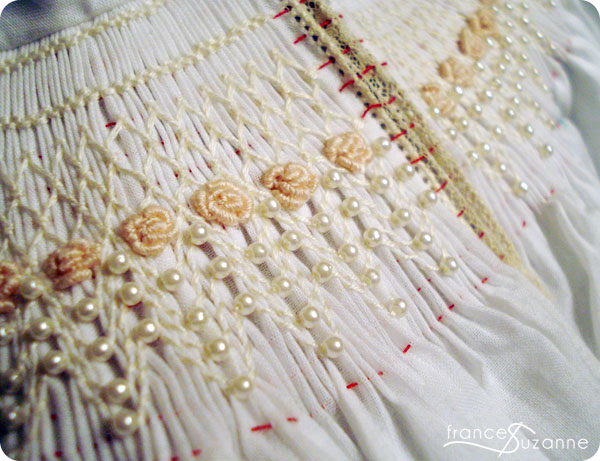
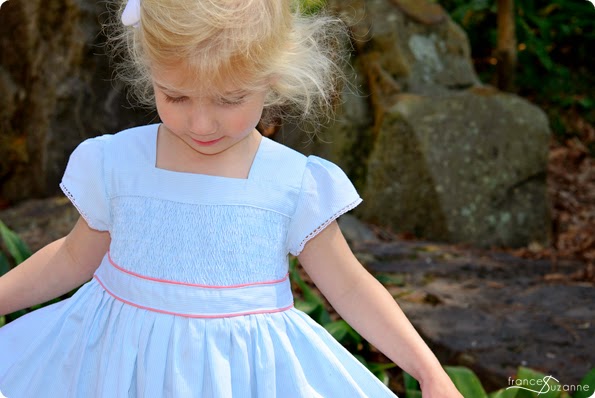
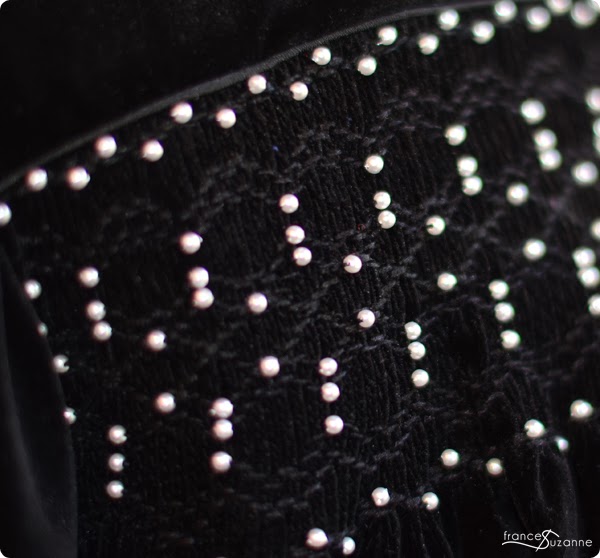


Great post! I am actually considering making a garment with some true smocking. A few monthes ago you asked on facebook what type of sewist you are. At that time I asnwered quick an dirty. That was true at the beginning but I realized I am not anymore. I am now, like you spending more time per garment and enjoying it. Did you see my Ishi dress last week, that is a technique you would love as well.
We can’t eliminate all of our quick sews either, but still like the uniqueness of handwork! Ohhhh…..your Ishi! We had seen the pocket technique before and LOVED IT {on a pouch}!! As for all those other stitches you added, WOW…just WOW!
We tried to find an email address for you, but couldn’t find one, so maybe this will work. We were wondering if we might could use an image of your Ishi dress with a link to your post. We think it will be a perfect fit for an upcoming post on smocking inspiration!!! THANK YOU!
I would be honored! but I might be late with my reaction 😉
if you want to contact me you could use inspinration(at)gmail.com
Well! This certainly begins to demystify things. Thanks for the great beginners post. I thing my daughter, Allegra, who loves to embroider and sew by hand might enjoy smocking.
YES, YES, YES!! Allegra would be a fan of smocking….especially since she likes embroidery!!
YAY!!! There’s so much more smocking I’d like to be doing. Eliza recently decided she wants to wear smocked bishops after boycotting them for the first four years of her life. I’ve got a pleater and everything, but the time it’ll take just overwhelms me. I hope this will be motivating for me!!!
My two favorite resources (so far) were the DVD that came with my Read pleater and Martha Pullen’s DVD “Smocking” http://store.marthapullen.com/p-4864-smocking-dvd
Ok. Now I’ve decided. I’m pleating today or tomorrow.
So glad Eliza has lifted the ban on smocked bishops!! And, thanks for adding your go-to resources {there are SO MANY places to look for some GOOD STUFF!}. We’ll be looking for that new bishop in the upcoming months…
This is a great post! Thank you for all of the links especially, I have been wondering how to get started with smocking for such a long time!
Glad you are interested in learning about smocking! There’s a lot of interest….and a lot of anxiety too {that doesn’t have to be there!}.
Well, bless your darling little smocking hearts !!!!! I hope that your followers will go to http://www.smocking.org and see what a special guild it is and all the educational opportunities offered. Warm regards to you special ladies. Susan VH
SUSAN! We’ve missed you!!! Yes, SAGA is a special group of dedicated ladies… As we continue to “talk” about smocking here, I hope you chime in with your knowledge as well!
Great post! This post is really helpful as I would love to do smocking but don’t even know where to start!
Prepare yourself….we aren’t done with the topic quite yet :)! Glad you are interested in learning about it!
I am so glad that you are showing some smocking, it seems to be disappearing everywhere else! I only started smocking myself a few years ago and I love to see the beautiful work that others do, its so inspiring. This is such a great post, when I first started smocking I was so lost and I didn’t know where to find the information that you have so neatly presented here. Thank you.
Thanks for those kind words, Tenille! And, yea for you to jump in there and learn to smock!! Once you’ve mastered a few stitches, we think geometric smocking takes less thought than keeping up with a cross-stitch pattern…
Great post!
For any of your Canadian readers, my good friend Judith Marquis is one of Canada’s most well know smocking teachers and pattern designers. http://www.amberlane.ca
She taught me how to do picture smocking, tatting and silk ribbon embroidery. When she isn’t teaching here in the Great White North, she often teaches at SAGA and U.S. smocking guilds.
Thanks for jumping in there, Deb, and adding another resource!
You forgot to mention Italian (needs a pleater) and counterchange (no pleater required) smocking. There are ladies in my guild who rarely do English or American.
There are ladies in my guild who rarely do English or American.
One of my favorite resources is the book “A – Z of Smocking” by the same publishers as AS&E magazine. It’s a complete smocking reference, and it has all those great step-by-step pictures. With that one book, you could teach yourself to smock.
(I think Lisa is mistaken in her definition of American smocking. You might want to double check that.)
Italian smocking looked interesting, and something I wasn’t familiar with it. As for the counterchange smocking – is that similar to honeycomb smocking that has made a resurgence on blogs and pinterest recently? I was thinking it was more of a smocking technique…not a type. I’ve got so much to learn about smocking still!! When I was searching the two types of smocking you had mentioned, I ran across “lattice smocking” too. It looked intriguing as well. I understand American smocking to be the manipulation of fabric…and done without a pleater. The way you manipulate it is up to you…whether by transfer dots or other means… Then, your method of manipulation affects the look of the garment. But, again, this is something we haven’t tried yet…
A-Z Books: YES, YES, YES!! These books are phenomenal!! We don’t have the smocking one, but have some of the embroidery ones….and they are GREAT! You’re right…the step-by-step pictures and instructions could definitely teach someone to smock / embroider / etc. {whatever the title of the book suggests}.
Thanks for adding a go-to resource as well!!
Love this post.Let’s bring heirloom sewing back. I love all Children’s Corner patterns, there is a great Facebook group that’s full of tips and alternate design ideas. I love The Old Fashioned Baby, along with some sites already mentioned. I hope you plan to discuss fabric and shops. So happy to see this topic!
And, we love your enthusiasm!!! Children’s Corner patterns are great….and the fit is dead-on for our nieces… We were “saving” the Old Fashion Baby resource for our upcoming hand embroidery posts :)!!! Fabrics and shops WOULD BE a great topic – THANKS for the SUGGESTION / INPUT {we will work toward that}!!
i love using anything from country bumpkin and of course Micié Mooney’s beginning smocking book. They are my favorite to teach from.
Country Bumpkin = WONDERFUL!! Its great to know that Creations by Michié has a beginning smocking book…we were familiar with her patterns, but weren’t aware of this other resource.
Okay…we had to update our original blog post with Creations by Michié!!
I’m looking forward to seeing what else you two have to say about this! I recently saw something that looked like a mix of American and English smocking- it was pleated first, but by hand, and the smocking stitches were done after the entire piece was pleated. That’s how I was planning on ‘testing the waters’ for my first go at smocking, but the article I originally read has vanished. I might ‘wing it’ and try that method anyway. =)
We are tickled you want to “give it a try!!” And, yes, many smockers pleat by hand prior to smocking….we haven’t yet!! Maybe we can find some resources for you regarding this method…we’ll be on the lookout!
That would be awesome! Thank you. =)
Thank you so much for all your smocking tutorials and videos. I’ve just finished a smocked bishop, and I could not have done it without your help. If you’d like to see it, here’s a link to my blogpost:
http://stylememary.blogspot.com/2016/03/a-smocked-bishop-for-easter.html
Thanks again for sharing so much of your knowledge!
Mary